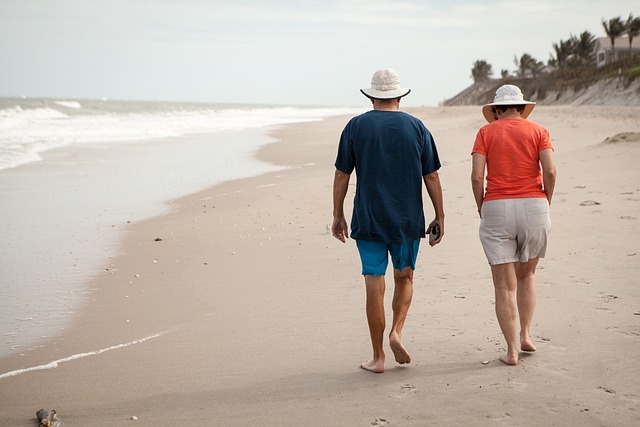Are you a senior, a family member, or a caregiver concerned about the safety of older adults? Look no further, because this article on pets and senior safety is here to provide you with comprehensive and detailed information. From the benefits of having a pet to the precautions that need to be taken, this long-form article covers all aspects of this important subject. Designed to be easily understood by a 9th grader, it aims to educate and inform readers about the positive impact pets can have on senior well-being and the precautions that should be considered to ensure a safe and healthy living environment. So, let’s dive into the world of pets and their role in senior safety.
Benefits of Pets for Seniors
1.1 Companionship and Emotional Support
Having a pet can provide much-needed companionship and emotional support for seniors. Pets can be loyal and loving friends, always there to listen and provide comfort. For seniors who may feel lonely or isolated, having a pet can make a world of difference. The presence of a pet can help alleviate feelings of depression and anxiety, providing a sense of purpose and meaning to their lives. Additionally, pets offer unconditional love and acceptance, which can boost self-esteem and overall well-being.
1.2 Stress Reduction and Mood Enhancement
Pets have a remarkable ability to reduce stress and improve mood. Spending time with a pet can reduce levels of cortisol, the stress hormone, and increase the production of oxytocin, the feel-good hormone. This can lead to a calmer state of mind and improved overall emotional well-being. Whether it’s cuddling with a cat, playing fetch with a dog, or simply watching fish swim in an aquarium, interacting with pets can bring joy and relaxation to seniors.
1.3 Increased Physical Activity and Exercise
Pets can encourage seniors to engage in physical activity and exercise, which is crucial for maintaining good health. Dogs especially need regular walks, providing a great opportunity for seniors to get moving and stay active. Walking a dog can not only improve cardiovascular health but also strengthen muscles and bones. Even caring for other pets, such as cats or birds, involves physical activity like cleaning cages or playing with toys. Regular physical activity helps seniors maintain mobility, strength, and independence.
1.4 Sense of Purpose and Responsibility
Caring for a pet gives seniors a sense of purpose and responsibility, which can be incredibly fulfilling. Having a pet to take care of creates a routine and daily tasks that need to be completed, providing structure to their days. This sense of purpose can bring a renewed sense of meaning and fulfillment to seniors’ lives, boosting their overall well-being. The sense of responsibility that comes with pet ownership also gives seniors a sense of control and agency in their lives.
1.5 Improved Cognitive Health
Pets can also have a positive impact on seniors’ cognitive health. Interacting with pets stimulates the brain and can help improve memory, attention, and problem-solving skills. For seniors with cognitive conditions such as Alzheimer’s or dementia, the presence of a pet can provide comfort and promote a sense of normalcy. Pets can also help reduce sundowning, a common symptom of dementia where confusion and agitation occur later in the day. Overall, having a pet can contribute to better cognitive functioning and mental stimulation for seniors.
Precautions for Seniors Owning Pets
While there are numerous benefits to owning a pet, seniors should also consider the following precautions before bringing a pet into their lives.
2.1 Allergies and Health Conditions
Before getting a pet, seniors should consider any allergies or health conditions they may have. Some pets, such as cats and dogs, can trigger allergies in certain individuals. Seniors with respiratory conditions or compromised immune systems should be especially mindful of potential allergens. It’s important to consult with a healthcare professional to determine if owning a pet is safe for their specific health needs.
2.2 Physical Limitations and Safety Hazards
Seniors need to assess their physical limitations and consider any potential safety hazards that may arise from owning a pet. For example, large or energetic dogs may be too difficult for seniors to handle, increasing the risk of falls or injuries. Seniors with mobility issues may need to consider pets that require less physical exertion, such as cats or small dogs. It’s crucial to choose a pet that matches their abilities and won’t pose a safety risk.
2.3 Financial Responsibility
Owning a pet comes with financial responsibilities, such as food, veterinary care, and grooming expenses. Seniors should carefully consider their budget and ensure that they can afford the costs associated with pet ownership. Regular veterinary visits and preventive medications can be particularly costly. It’s important to factor in these expenses and make sure they can be comfortably managed within their financial means.
2.4 Availability of Support
Seniors should also consider the availability of support when it comes to owning a pet. They may need assistance with certain aspects of pet care, such as grooming, exercise, or transportation to vet appointments. Having a support network of family, friends, or neighbors who can lend a helping hand can make pet ownership more manageable and enjoyable for seniors. It’s important to have a plan in place for times when extra support might be needed.
2.5 Long-term Commitment
Owning a pet is a long-term commitment, and seniors should carefully consider the longevity of pet ownership. Different pets have different lifespans, and seniors should choose a pet that aligns with their own life expectancy and future plans. It’s essential to think about what will happen to the pet if the senior needs to move into a retirement community or if they pass away. Planning for the long-term well-being of the pet is crucial in responsible pet ownership.
Choosing the Right Pet
Choosing the right pet is a crucial decision for seniors. Here are some factors to consider when making this important choice.
3.1 Assessing Lifestyle and Needs
Seniors need to assess their lifestyle and individual needs when considering a pet. Some pets require more time, attention, and physical activity than others. Seniors with an active lifestyle and plenty of free time may enjoy the companionship of a dog, while seniors with a more relaxed lifestyle might find a low-maintenance pet like a cat or a fish more suitable. It’s important to consider how a pet will fit into daily routines and lifestyle preferences.
3.2 Considerations for Different Types of Pets
Different types of pets have different care requirements, temperaments, and needs. Seniors should research and consider these factors when choosing a pet. For example, dogs require regular exercise and attention, while cats are more independent. Smaller pets like birds or fish may require less hands-on care but can still provide companionship. It’s important to choose a pet that aligns with seniors’ abilities, preferences, and living situations.
3.3 Adopting a Shelter Pet
Adopting a pet from a shelter can be a rewarding experience for seniors. Many older animals are in need of loving homes, and adopting a senior pet can be a perfect match for seniors themselves. Older pets often come trained and may require less energy and attention. Additionally, shelters can help match seniors with the right pet and provide ongoing support and resources. When adopting, it’s important to consider the pet’s background, health, and compatibility with seniors.
3.4 Obtaining a Pet from a Reputable Breeder
If seniors have specific preferences regarding breed, size, or temperament, they may consider obtaining a pet from a reputable breeder. Reputable breeders prioritize the health and well-being of their animals and can provide documentation and information about the pet’s background. It’s important to do thorough research and visit the breeder in person to ensure they are following ethical practices. Seniors should prioritize responsible breeding and avoid supporting puppy mills or unethical sources.
3.5 Considering Age and Energy Level of the Pet
Seniors should consider the age and energy level of the pet they choose. Puppies and kittens are adorable, but they require a lot of time, attention, and training. For seniors who may have limited energy or mobility, older pets or those with lower energy levels might be a better fit. Older pets are often calmer and may already be trained, making them a great match for seniors looking for companionship without the demands of a young pet.
Safe Environment for Pets and Seniors
Creating a safe environment is essential to ensure the well-being of both pets and seniors. Here are some considerations for maintaining a safe living space.
4.1 Pet-Proofing the Home
Pet-proofing the home is crucial to prevent accidents and injuries. Seniors should secure any potentially dangerous items, such as chemicals, medications, or small objects that pets could swallow. They should also ensure that electrical cords are safely tucked away to avoid chewing. Investing in pet gates or creating designated pet-free areas in the house can help manage pet access and prevent them from entering potentially hazardous zones.
4.2 Ensuring Proper Supervision
Proper supervision is necessary to prevent accidents and ensure the safety of both pets and seniors. Seniors should be physically and mentally capable of keeping an eye on their pet to prevent them from getting into trouble or harming themselves. If supervision becomes challenging, seniors may consider using baby monitors or pet cameras to keep an eye on their pet when they can’t be in the same room.
4.3 Preventing Falls and Trips
Falls and trips can be especially dangerous for seniors, so it’s important to create a safe environment to prevent these accidents. Seniors should ensure that walkways and pathways are clear of pet toys, food bowls, or clutter that can pose a tripping hazard. Installing grab bars and non-slip mats in areas prone to slips, such as bathrooms or near food bowls, can help prevent falls. It’s essential to maintain a clutter-free living space to minimize the risk of accidents.
4.4 Establishing a Routine
Establishing a routine is beneficial for both pets and seniors. Having a set schedule for feeding, exercise, and playtime can help maintain stability and consistency in their lives. Routine also helps pets understand what is expected of them and can prevent behavioral issues. Seniors should strive to stick to a regular routine to ensure their pets’ well-being and adjust it as needed to accommodate any changes in their own health or abilities.
4.5 Creating a Pet-Friendly Space
Creating a pet-friendly space in the home is important for the comfort and safety of both pets and seniors. Seniors should provide their pets with a designated area that includes a comfortable bed, toys, and access to food and water. This space should be easily accessible for pets and designed to meet their needs. Seniors may also consider installing ramps or steps to help pets access higher areas or furniture without putting themselves at risk of injury.
Maintaining Pet Health and Safety
Ensuring the health and safety of pets is crucial for their overall well-being. Here are some key aspects to consider when it comes to pet care.
5.1 Regular Veterinary Care
Regular veterinary care is essential for maintaining the health of pets. Seniors should ensure their pets receive routine check-ups, vaccinations, and preventive treatments. Regular veterinary visits can help identify potential health concerns early on and provide appropriate treatments. Seniors should keep a record of their pets’ vaccinations and medical history, making it easier to share information with veterinarians and provide them with the necessary care.
5.2 Vaccinations and Preventive Medications
Vaccinations and preventive medications play a vital role in keeping pets healthy and protected from diseases. Seniors should work with their veterinarians to determine the appropriate vaccination schedule for their pets. Preventive medications for flea and tick control, heartworm prevention, and parasite control should also be administered on a regular basis as recommended by the veterinarian. Following these preventive measures can help ensure the well-being and longevity of the pet.
5.3 Proper Nutrition and Hydration
Proper nutrition and hydration are key to maintaining a pet’s health. Seniors should provide their pets with a balanced and appropriate diet based on their age, breed, and specific dietary needs. Overfeeding should be avoided to prevent obesity and related health issues. Fresh water should be available at all times to keep pets properly hydrated. Seniors should consult with their veterinarian to determine the best diet and feeding routine for their pets.
5.4 Exercise and Mental Stimulation
Regular exercise and mental stimulation are crucial for keeping pets physically and mentally healthy. Seniors should provide opportunities for their pets to engage in physical activities that match their energy levels and abilities. This can include daily walks, interactive play sessions, or puzzle toys to keep them mentally stimulated. Physical and mental exercise helps prevent boredom, obesity, and behavioral problems in pets.
5.5 Grooming and Hygiene Practices
Maintaining proper grooming and hygiene practices is important for the comfort and health of pets. Seniors should brush their pets’ fur regularly to prevent matting and to promote a healthy coat. Nails should be trimmed to a safe length to avoid discomfort or injury. Regular bathing can help keep pets clean and prevent skin issues. Dental care should not be overlooked, and seniors should make sure their pets receive regular dental check-ups and teeth cleaning to prevent periodontal disease.
Ensuring Senior Safety Around Pets
While pets can provide numerous benefits for seniors, it’s important to ensure their safety. Here are some considerations to keep in mind.
6.1 Proper Lifting and Handling Techniques
Seniors should learn and utilize proper lifting and handling techniques when interacting with pets. This is especially important for larger or heavier pets. Seniors should avoid straining their backs by using proper lifting techniques, such as bending the knees, keeping a straight back, and utilizing assistance equipment like ramps or slings if needed. Taking care to lift and handle pets safely can help prevent injuries to both the senior and the pet.
6.2 Hygiene and Handwashing
Maintaining good hygiene and practicing proper handwashing is crucial when interacting with pets. Seniors should wash their hands thoroughly with soap and water after handling their pets, especially before preparing or consuming food. This helps prevent the spread of bacteria, parasites, or allergens that may be present on the pet’s fur or skin. Proper hand hygiene is essential to protect both seniors and their pets from potential diseases or infections.
6.3 Identifying and Managing Allergies
Seniors should be aware of potential allergies to their pets and take necessary precautions. Common allergens include pet dander, saliva, or urine. Seniors should watch for symptoms such as sneezing, wheezing, itching, or watery eyes that may indicate an allergic reaction. If allergies are a concern, seniors can talk to their healthcare provider for guidance on allergy management strategies, including medications or lifestyle modifications to minimize exposure to allergens.
6.4 Recognizing Behavior Changes
Monitoring and recognizing behavior changes in pets is important to ensure senior safety. Seniors should be observant of any unusual behavior, such as aggression, fear, or signs of illness in their pets. Sudden changes in behavior can indicate underlying health issues or pain. Seniors should promptly seek veterinary advice if they notice any concerning behavior changes in their pets. Early intervention can help prevent safety risks and ensure the well-being of both seniors and pets.
6.5 Addressing Aggression or Fear in Pets
If a pet displays aggressive or fearful behavior, it’s crucial to address these issues promptly and appropriately. Seniors should consult with a professional, such as a veterinarian or a certified animal behaviorist, who can provide guidance on managing and training the pet. Addressing aggression or fear early on can help prevent potential injuries or stressful situations for seniors. It’s important to prioritize the safety and well-being of both the senior and the pet in these circumstances.
Benefits of Pet Therapy for Seniors
Pet therapy, also known as animal-assisted therapy, can provide numerous benefits for seniors. Here are some advantages of incorporating pet therapy into seniors’ lives.

7.1 Reduction of Loneliness and Depression
Pet therapy can help alleviate feelings of loneliness and depression in seniors. The presence of a therapy animal can provide companionship and a source of emotional support, reducing feelings of isolation and improving overall mood. Pets have a unique ability to provide unconditional love and acceptance, which can have a significant positive impact on seniors’ emotional well-being.
7.2 Lowering Blood Pressure and Stress Levels
Interacting with therapy animals has been shown to lower blood pressure and reduce stress levels in seniors. The calming presence of an animal can help reduce anxiety and promote a sense of relaxation. Petting or cuddling a therapy animal can trigger the release of endorphins, which are natural mood elevators, further enhancing the calming effects. The overall reduction in stress can contribute to improved cardiovascular health for seniors.
7.3 Enhancing Social Interaction and Communication
Pet therapy can enhance social interaction and improve communication skills for seniors. Therapy animals can act as conversation starters and help facilitate engagement with others, whether it’s fellow residents in a senior living community or therapists and caregivers. The presence of an animal can create a common ground for conversation and promote social connections, reducing feelings of social isolation and improving overall social well-being.
7.4 Improving Mobility and Motor Skills
Therapy animals can also help improve mobility and motor skills in seniors. Whether it’s walking a dog or engaging in activities with a therapy animal, physical interaction and exercise can help seniors maintain or improve their physical capabilities. Walking a therapy dog, for example, can help seniors increase their balance, strength, and overall mobility. The physical interaction involved in pet therapy can contribute to a more active and independent lifestyle for seniors.
7.5 Providing Purpose and Meaning
Pet therapy can provide seniors with a sense of purpose and meaning. Participating in pet therapy programs may involve responsibilities such as grooming, feeding, or exercising therapy animals. These tasks give seniors a sense of control, responsibility, and purpose, which can boost their self-esteem and overall well-being. The opportunity to make a positive impact on the well-being of therapy animals can also bring a sense of fulfillment and purpose to seniors’ lives.
Pet-Assisted Living Facilities
Pet-assisted living facilities, also known as pet-friendly senior living communities, offer seniors the opportunity to live with their pets while receiving the care and support they need. Here are some key points to consider regarding pet-assisted living facilities.
8.1 Overview of Pet-assisted Living
Pet-assisted living facilities are specifically designed to accommodate seniors who wish to live with their pets. These facilities provide senior-friendly housing options that cater to the needs of both the seniors and their pets. They offer various amenities and services, such as pet-friendly apartments, designated pet exercise areas, grooming services, and even pet-centric social activities. Pet-assisted living facilities understand the importance of the bond between seniors and their pets and provide an environment that promotes their well-being.
8.2 Selection and Evaluation of Facilities
When selecting a pet-assisted living facility, it’s important to evaluate and compare different options. Seniors and their families should consider factors such as location, available pet-related amenities and services, pet policies, and the overall reputation of the facility. It’s advisable to visit different facilities in person, ask questions about their pet policies, and assess whether the facility meets both the seniors’ and pets’ needs. Researching reviews and recommendations can also provide valuable insights into the quality of different facilities.
8.3 Safety Protocols and Guidelines
Pet-assisted living facilities prioritize the safety and well-being of both the senior residents and their pets. They typically have safety protocols and guidelines in place to ensure that pets are well-behaved, vaccinated, and properly cared for. These facilities may have rules regarding leash usage, pet waste disposal, and noise control. Seniors and their pets are expected to adhere to these guidelines to ensure a harmonious and safe living environment for everyone.
8.4 Benefits for Seniors and Families
Pet-assisted living facilities offer numerous benefits for both seniors and their families. Seniors can enjoy the companionship and emotional support that their pets provide while receiving necessary care and support. Families can have peace of mind knowing that their loved ones are living in a pet-friendly environment that promotes their well-being. The presence of pets in these facilities can enhance the overall quality of life for seniors and contribute to a sense of home and happiness.
8.5 Factors to Consider for a Smooth Transition
Transitioning to a pet-assisted living facility can be a significant change for seniors and their pets. Here are some factors to consider for a smooth transition:
- Familiarize pets with the new environment gradually.
- Maintain routines and familiarize pets with new caregivers or staff members.
- Ensure proper identification and update contact information in case of any emergencies.
- Communicate with facility staff about any specific needs or concerns regarding the pets.
- Provide comfort items from the previous home, such as beds or toys, to help pets feel more at ease.
- Monitor the pets’ adjustment and seek support or guidance from facility staff if needed.
Preparing for Emergencies
Being prepared for emergencies is crucial for both seniors and their pets. Here are some important considerations to keep in mind.
9.1 Emergency Plans for Pets and Seniors
Seniors should have emergency plans in place that include provisions for their pets. These plans should outline what to do in case of a natural disaster, medical emergency, or unforeseen circumstances. Seniors should identify a trusted family member, friend, or neighbor who can assist with their pets’ care if they are unable to do so. It’s important to have emergency contact information readily available and to share it with their chosen caregiver.
9.2 Identification and Microchipping
Proper identification and microchipping are essential to ensure the safe return of pets in case they get lost or separated from their owners. Seniors should ensure their pets are properly tagged with their contact information and that the contact details are up to date. Microchipping is also recommended as an additional layer of identification. It’s crucial to keep the registration information associated with the microchip updated and accessible to facilitate a swift reunion if needed.
9.3 Emergency Supplies and First Aid Kits
Preparing emergency supplies and first aid kits is important for both seniors and their pets. Seniors should have an emergency kit that includes essential items such as medications, medical records, water, non-perishable food, and any necessary equipment. It’s also advisable to have a first aid kit specifically designed for pets, which should include basic supplies such as bandages, antiseptic solution, and tweezers. Being prepared can help mitigate potential risks and ensure the safety of both seniors and their pets.
9.4 Establishing Support Networks
Seniors should establish support networks that can assist them in case of emergencies involving their pets. Family members, friends, or neighbors who are aware of the seniors’ situation and willing to provide assistance can play a crucial role in ensuring the well-being of both seniors and their pets. It’s important to have open communication with these support networks and to establish clear plans and expectations in case of emergencies.
9.5 Disaster Preparedness Tips
In addition to the aforementioned measures, here are some disaster preparedness tips for seniors and their pets:
- Keep an updated list of emergency contacts, including the contact information for local animal shelters, veterinarians, and pet-friendly hotels or accommodations.
- Identify evacuation routes and pet-friendly shelters in the area and familiarize yourself with their policies.
- Prepare a pet emergency kit that includes food, water, medications, pet supplies, and comfort items.
- Practice evacuating with pets to ensure a smooth process during actual emergencies.
- Stay informed about weather and emergency alerts in the area to be prepared for potential threats.
Conclusion
Pets can bring immense joy, companionship, and a sense of purpose to the lives of seniors. The benefits of pet ownership for seniors, including companionship, stress reduction, increased physical activity, improved cognitive health, and pet therapy, are numerous. However, it is essential for seniors to take precautions and consider their specific needs and circumstances before bringing a pet into their lives. By carefully choosing the right pet, creating a safe environment, and prioritizing the health and safety of both seniors and pets, the bond between seniors and their pets can thrive, providing a mutually beneficial and fulfilling relationship. With proper planning, support, and resources, pets can continue to be cherished and valued members of seniors’ lives, enhancing their overall well-being and happiness.




